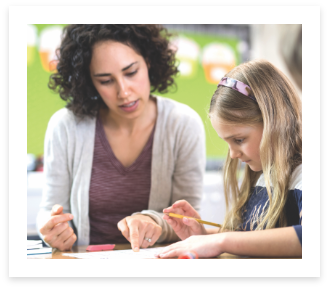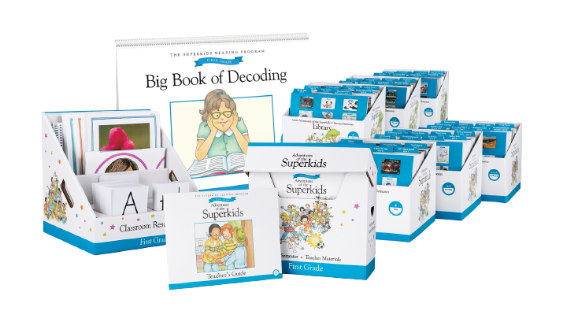Superkids English Language Arts and Reading Lesson Plans Build Essential K–2 Skills
The Superkids Reading Program lessons incorporate all aspects of reading and the language arts, integrating and overlapping skills from unit to unit and grade to grade.
Following a unique, systematic, and explicit instructional path, Superkids builds the essential foundation for efficient, fluent reading and effective comprehension that primary students need. Watch the short video to explore the path.
Download the Skills Overview to explore the Superkids scope and sequence.
Daily Instructional Plan
Superkids makes every minute of your literacy block count. Because of the way instruction is integrated, no time is wasted teaching skills in isolation.
Comprehensive English language arts and reading lesson plans incorporate skills throughout three consistent parts: Word Work, Reading, and Writing. Review the instructional time, setting, and materials for grades K–2 in the Daily Instructional Plan.
View Daily Instructional Plan
Lesson Plans in The Superkids Reading Program Include Word Work, Reading, and Writing
As students progress from kindergarten to second grade, instruction and practice within the Word Work, Reading, and Writing lesson parts grow in complexity and rigor. The Superkids Reading Program for kindergarten, first grade, and second grade includes English language arts and reading lesson plans that are comprehensive and engaging. Students are expected to meet the following high-level goals in each grade.
| Kindergarten | First Grade | Second Grade | |
|---|---|---|---|
Word Work |
Students learn the letters of the alphabet, one sound for each letter, and then apply their new skills to blend letter-sounds to read and write words and sentences. | Students master more complex phonetic elements and learn to decode and encode structural patterns. | Students consolidate their understanding of all phonetic elements and apply it in fluent reading of grade-level text. |
Reading |
Reading focuses on developing strong blending, decoding, and fluency skills while also building comprehension. Read-alouds build background knowledge and listening comprehension. Learn more. |
Students’ comprehension and fluency skills increase greatly as they read longer and more complex literary and informational texts. Read-alouds build vocabulary and prepare students to read more rigorous text. Learn more. |
Students read authentic literary and informational texts that have not been controlled for decodability and apply comprehension skills to longer, more complex texts. Learn more. |
Writing |
Students learn basic mechanics and aspects of the writing process. Instruction progresses from drawing to writing in each major text type. | Students use the writing process to write narratives, informational texts, and opinion pieces. | Students use the writing process to write longer, more structured narratives, informational texts, and opinion pieces. |

Assessment and Differentiated Instruction
In Superkids, ongoing assessment reveals students’ progress and informs teachers’ decisions about reteaching, challenging students, grouping students, and differentiating instruction.
- Assessment Books, online printable tests, online interactive tests, and other resources provide ample opportunities to assess students formally and informally.
- Superkids is designed for teachers to deliver truly differentiated instruction, rather than differentiating text. Program resources enable teachers to use their expertise to meet the needs of their below-, on-, and above-level students as well as English language learners.

Online Resources for Teaching and Learning
The Superkids Reading Program features robust to support teaching and learning with this comprehensive program. These include reading lesson-planning tools, on-demand training videos, progress reports, digital versions of print materials, , and other interactive resources.
Teachers, students, families, and administrators access these resources at school and at home on Zaner-Bloser’s central platform for digital products and program content, MyZBPortal.com. Annual access is included with the purchase of print materials.
View Online Resources Brochure

Program Components for Grades K–2
Superkids provides everything you need to be successful. Materials are designed to pack a bigger punch—precisely integrated and to the point, yet comprehensive.
The Superkids Phonemic Awareness curriculum complements Superkids with 180 daily lessons for building phonological and phonemic awareness.
Standards-Based Instruction
Superkids is fully aligned to the Common Core and other state standards. The program teaches the critical foundational skills and presents students with rich informational and complex text at each grade level. To request the correlations to your state standards, contact Zaner-Bloser.
Contact Zaner-Bloser
